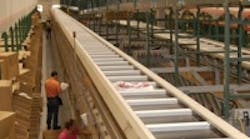When you're responsible for distribut -ing dreams--hundreds of thousands of dreams--you want to be sure you do it right. That's the day-to-day business of David's Bridal. This national retailer of virtually everything to do with weddings (You add your own potential spouse.) currently supplies 275 retail outlets from its two distribution centers in eastern Pennsylvania. The newer center is located in Bristol, just north of Philadelphia. Its unpretentious building houses more than 150,000 square feet of everything the bride and her brides maids need--from shoes to tiaras, ribbons to cake cutters.
About three years ago, Tony Coccerino Jr., direc tor of operations, and other company managers, knew their business was at a crossroads. It needed a guide to point them in the right direction. The guide turned out to be Bryan Jensen, vice president, St. Onge Co., York, Pa.
When to ask for help
Jensen metaphorically describes when a company should seek out a project manager, or third-party assis tance: You don't call a lawyer if you don't need a lawyer. And when you do need a lawyer, you don't rush off to law school to begin studying.
"The same applies to material handling," he says. "Our business is to bring to the client a level of expertise he either does not have available when looking at technical aspects of a system, or does not have time to dedicate to project management."
The latter was the case with David's Bridal and Tony Coccerino. "I have a business to run," says Coccerino. "We looked at the potential growth in our business and assigned a network analysis team to review the options."
That's when they turned to the experts from St. Onge who began working on a master plan—Phase I.
He adds that the plan Jensen and his team developed far exceeded what he, Coccerino, had imagined. "It essentially changed the way we do business. In the end, we were able to cut about a day and a half from our time to market and reduce costs all along the line." That's the kind of help people look for when they hire a project manager.
Jensen says, while most projects follow similar paths, no two are alike. Phase I, or the design phase, is alternative driven. "Any insight [for how it does business] you bring to the client," says Jensen, "has to improve upon what they are already doing, especially if they're already doing it well."
In this case, the big idea from Phase I was essentially to split the company's business into two parts. Its existing facility, in Conshohocken, was distributing garments on hangers (GOH) as well as flats, or merchandise in cartons. The optimal design called for converting the Conshohocken operations to distribute GOH exclusively and start a new facility for distribution of ˚ats. With the major hurdle of what to do cleared, Jensen and his team, which varied in number, depending on the phase of the project, helped the client with the next step—identify Bristol as the right location for this new part of the business.
Phase I
There are plenty of ways to distribute cartons from a distribution center to retail stores. " In this instance, we gave the client four options for distributing its product," says Jensen. "Because those options are alternative driven, it [the client] can see the impact if it puts less money here, it will have to put more money there. These are all values—the realities of going for the longer time for payback versus instant gratification, for example."
Jensen says clients also have certain predispositions toward a brand or technology, so having alternatives based on data—hard values—helps to take any "emotion" out of the equation.
And, getting the data to generate those alternatives is not always the easiest of tasks, he says. "Most companies have the information we need to create the scenarios; the challenge comes in extracting the data."
Typically, companies are collecting a lot of information related to SKUs but not enough about dimensions and weights. More often than not, the critical factor in determining the core part of a material handling system will depend on the size of the units to be moved.
To get all the right numbers, Jensen and his team spent a lot of hours on the floor at the existing facility in Conshohocken. They watched what employees did and asked why it was done that way. "You have to learn the process," says Jensen, "because you don't want to design a plan that precludes them from doing their job as it exists now if they're efficient at it."
Knowing the client's business well forms the basis for the alternatives presented. Jensen likes to say the St. Onge team designs for equipment robust enough that will allow the client to serve its peak operating points, and be cost effiective at average running speeds. Knowing the client's business well forms the basis for the alternatives presented.
A project is not designed and managed for what is; it's all about what will be. Jensen and his team spent time with David's Bridal's procurement managers to discuss packaging alternatives and learn of any changes that might occur before the new system was installed. David's was in the process of upgrading its WMS, so that had to be another facet added to the mix, mostly in the category of "what to watch for".
Finally, the project management team spent time with the compa ny's vendors to learn how product is shipped. Knowing how it will ar rive at the new facility determines whether changes that might enhance the project can be initiated from the supplier's end.
Phase II
The second phase of the project, after about 12 weeks of design work, is preparing for and sending out re quests for proposals (RFPs). At this point, details are paramount. So that all bids are created equally, even the most minute things have to be de ~ned in the RFP, says Jensen. In this situation, three RFPs were prepared: One covering conveyors and sorta tion, one for storage media, and a third for mobile equipment.
Depending on the level of client in volvement, typically the project man ager becomes a negotiator or serves as an agent for its client. "The team from St. Onge set up meetings with potential vendors who then came in or took us on visits to existing facili ties," says Coccerino.
Getting a project manager involved in the vendor selection process can add some weight for smaller businesses. Typically, larger equipment vendors are slow to respond to requests from small companies, says Jensen.
In addition, because the project manager is more familiar with state-of-the-art equipment, it can steer the client toward better options, more reliable vendors or alternative costs.
"We take an engineered labor standards approach to evaluate head count involvement for each level of the task at hand," says Jensen, "so the headcount versus capital investment comparisons can be made."
Phase III
After the client has signed on the equipment vendors, the project manager's role shifts a bit from be ing an adviser to an overseer. In this case, the St. Onge team, which varied from three to five people, depending on complexity of the tasks at hand, found the architect to complete the "white space," or internal configuration, of the shell David's was leasing.
"When the equipment starts show ing up," says Jensen, "we know the order of installation. We're here to ensure all targets are being hit. Some clients prefer to run the whole pro cess through its general contractor; others like to do it themselves."
In any case, the project manager has to be there to check the instal lation of equipment against the en gineered drawings and, during the commissioning of equipment, to make sure everything is as specified.
The ultimate test is going live. Coc cerino says the smoothness of the transition of processing orders in two locations was nearly transparent to its retail stores. Product was moved from the old location to the new dis tribution centers in batches of styles. This was done mostly on weekends.
"When an order came in for a par ticular style," he says, "we could shunt that part of the order to whichever location had the item and fulfill all
parts of the order at the same time. Most stores never knew we had made the switch." Because everything is shipped via small parcel carrier, there was no freight penalty for shipping split orders.
The end result of the project is an installation that blends very-arrow-aisle rack layout, man-aboard order picking trucks, a bomb bay-style sor tation system and the efficient use of automatic data collection.
How it works
As cartons of merchandise enter the distribution center, vendor-ap plied UPC labels are scanned and pallet loads built in the receiving area. The warehouse management system assigns a lift truck operator to the putaway task of moving those pallets.
The lift truck operator scans a carton label, and the WMS tells him, within three aisles either to the right or left of his current location, where to put the pallet. Items are matched to the rack location. Two or three cartons are placed in each location in the racks.
When tasked to fill an order, op erators receive the item's location and full cartons are retrieved from the racks and taken to the packing station. There, an operator picks the number of items required to fulfill the order, scanning each as it is removed from the original carton and placed in a second carton that will move via conveyor to the sortation area.
"We use the vendor's original car tons for storage," says Coccerino, "sending merchandise to the sorter and for sending partial carton loads back into storage."
If the order calls for a full carton, the order picker bypasses the pack ing station with the carton and puts it onto the conveyor destined for ship ping workstations. The WMS does all the decrementing of merchandise. Coccerino gets a lot of reuse from his corrugated cartons because he has given his vendors specifications for size and durability. "Our conveyor is not all that long or damaging," he says, "but we make sure we get cartons that will hold up in the system".
The company has also specified its shipping cartons to be durable to with stand the rigors of the UPS sortation process. Boxes are made with overlap ping tops to prevent damage to mer chandise when opened at the retail lo cations. Interlocking bottoms on the cartons reduce the amount of tape needed to close them, and they ride the conveyor better.
High-speed sorting
The bomb bay, or bottom-drop sorter, is 242 feet long and diverts merchandise to 204 destinations. Chutes were designed so that orders for as many as 600 stores can be sorted simultaneously. Employees at four manual induction areas place items received from packing station cartons onto one of the trays. The merchandise passes through a scanner array and down the proper chute.
Of the many sortation options available, this one fulfilled the requirements of the system best, says Coccerino. "The placement of the EuroSort solution gave us more room within the chutes to accumulate product, and it's simple to operate in terms of minimal maintenance. There's essentially no lubrication required and no air to drive any of the mechanical parts. It's also quiet running," he says.
Jensen, one thing about this project that made it difierent from others was the fact that his team was not creating a facility for expansion. "The big decision was essentially to split the existing business, consequently we were man aging for new ways of operating as well as finding ways to add efficiencies."
Bringing in outside help in the form of a project manager o˚ers several benefits: Expertise hired for only the period of time needed; continuity from design through going live is ensured; and flawless execution of the project is more than likely because the project manager is not distracted by other day-to-day requirements of his job.
For more information contact any of the participating vendors in the David's Bridal distribution center project:
- St. Onge Company, www.stonge.com;
- Century Conveyor, conveyor, www.centuryconveyor.com;
- EuroSort, sorter, www.eurosort.com;
- Steel King, racking, www.steelking.com;
- Raymond, very narrow aisle lift trucks, www.raymondcorp.com;
- Manhattan Associates, warehouse management system, www.manh.com;
- 3M, carton sealers, www.3m.com;
- Arbor Material Handling, lift trucks, www.arbor-inc.com.



